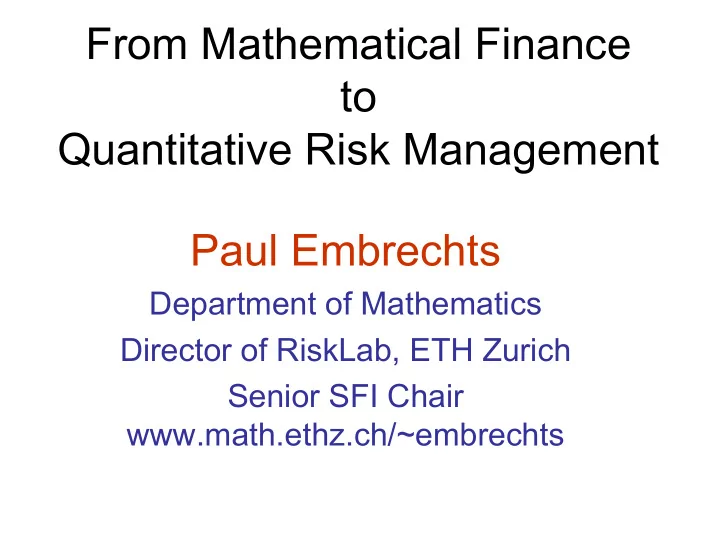

From Mathematical Finance to Quantitative Risk Management Paul Embrechts Department of Mathematics Director of RiskLab, ETH Zurich Senior SFI Chair www.math.ethz.ch/~embrechts
Ingredients/background are: • Basel Committee on Banking Supervision (Basel I, Basel I ½, Basel II, Basel II ½ or III) • Rules based solvency for Insurance (Solvency 1, Solvency 2, SST, …) • Model Uncertainty • Example 1: Micro correlation and CDO pricing • Example 2: Operational Risk under Basel II • QRM research topics and Conclusion(s)
Let us start with a statement by Lord Turner, Chairman of the FSA (now part of the Bank of England), on Mathematics and the Financial Crisis:
The Turner Review A regulatory response to the global banking crisis (126 pages) March 2009, FSA, London 1.1 (iv) Misplaced reliance on sophisticated maths There are, however, fundamental questions about The validity of VAR as a measure of risk (see Section 1.4 (ii) below). And the use of VAR measures based on relatively short periods of historical observation (e.g. 12 months) introduced dangerous procyclicality into the assessment of trading- book risk for the reasons set out in Box 1A (deficiencies of VAR). The very complexity of the mathematics used to measure and manage risk, moreover, made it increasingly difficult for top management and boards to assess and exercise judgement over the risks being taken. Mathematical sophistication ended up not con- taining risk, but providing false assurance that other prima facie indicators of increa- sing risk (e.g. rapid credit extension and balance sheet growth) could be safely ignored. 1.1 (v) Hard-wired procyclicality : …
1.4 (iii) Misplaced reliance on sophisticated maths: fixable deficiencies or inherent limitations? Four categories of problem can be distinguished: • Short observation periods • Non-normal distributions • Systemic versus idiosyncratic risk • Distinguishing risk and uncertainty Frank H. Knight, 1921
The by now famous, distinction in Knight’s work between: • Risk: randomness with knowable probabilities, and • Uncertainty: randomness with unknowable probabilities • A reference: “The Known, the Unknown, and the Unknowable in Financial Risk Management: Measurement and Theory Advancing Practice”, Edited by Francis X. Diebold, Neil A. Doherty & Richard J. Herring. Princeton UP, 2010.
A comment on Model Uncertainty: • X(1), X(2), … , X(d) d one-period risks with P&L distributions F(1),F(2), … ,F(d) (*) • A financial position Ψ (X(1),X(2), … ,X(d)) • A risk/pricing/valuation/hedging measure R • Calculate R( Ψ (X(1), … ,X(d))) under (*) and some condition on dependence between the X(i)-positions, i=1,…,d (**) • Example: calculate VaR(X(1) + … + X(d))
This leads to a Fréchet problem: • (*) and (**) are typically insufficient for cal- culating R( Ψ (X(1), … ,X(d))) MU !!!! • Remark: (*) and (**) can in general yield no, infinitely many or a unique solution • At best, one can calculate Upper - and Lower bounds: RL ≤ R( Ψ (X(1), … ,X(d))) ≤ RU This is without statistical uncertainty!
Non-understanding of the above has led/leads/will lead to problems: • Major bank on London market lost about 40 Mio USD on long dated Japanese basket options (infinitely many values) • Simulation of a two-line non-life insurance portfolio with marginal distributions given as (*) F(1)=LN(0,1) and F(2)=LN(0,16) and dependence: (**) Corr=50%? no solution! Corr=5%? no solution! Corr=0.1%? infinitely many solutions! hence MU in the latter case!!!! • Credit crisis (valuation and hedging of CDO tranches)
An example from the financial (or subprime mortgage) crisis: I. Securitization and Extremes
90% 7% 3% Distance!!!! Quality????
micro- The normal distribution Extremes matter Correlation matters
And the subprime crisis unfolded itself: • With increasing correlation: equity tranche became more valuable; the (super-)senior AAA ones less; mezzanine (MT) ?? • “Hence” MTs new CDO: CDO**2 and even CDO**3: huge Model Uncertainty!! • Volumes! LCFIs started warehousing senior AAA-tranches: 5 50 Bio USD (*) • Used as collateral till market collapsed and liquidity dried up (REPO(-105!) market)
(*) • The warehousing of AAA (super) senior tranches by several LCFIs was like holding Economic Catastrophe Bonds, waiting for the trigger to go off … and it did! • Note that those banks’ internal risk mana- gement models were putting a zero default probability on those tranches (**) and yet they were earning an above risk free rate of return the proverbial free lunch!
(**) The AIG-story: • AIGFP sold protection on super-senior tranches of CDOs, where the underlying portfolio con- sisted of loans, debt securities, asset-backed securities and mortgage-backed securities. • “The likelihood of any payment obligation by AIGFP under each transaction is remote, even in severe recessionary market scenarios“ (2006, AR) • “It is hard for us, without being flippant, to even see a scenario within any kind of realm of reason that would see us losing one dollar in any of those transactions.“ (8/2007, CEO of AIGFP)
For more details, see: Catherine Donnelly and Paul Embrechts The devil is in the tails: Actuarial Mathematics and the Subprime Crisis, The ASTIN Bulletin, 40(1), 1-33, 2010 See also www.math.ethz.ch/~embrechts
A further example from the realm of Financial (Quantitative) Risk Management: II. Operational Risk
An important question, no easy answer: does Operational Risk belong to the Known, the Unknown or the Unknowable?
Conclusion(s): • QRM is of increasing importance • Risk and extremes, with applications to insurance, finance, the environment … • Interesting research themes: * Rare event estimation (IS, EVT, MCMC, d large, …) * Network complexity, systemic risk * Bayesian hierarchical networks (stress testing) * Calibration versus statistical fitting * Robustness, sensitivity of risk estimates * Combining qualitative and quantitative, … and many more!
Thank You!
Recommend
More recommend